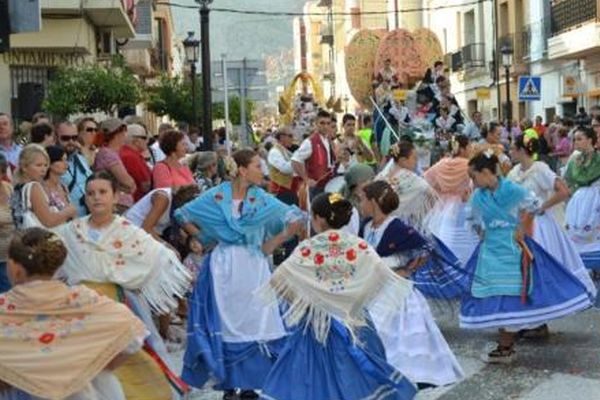

The region of Valencia Day is celebrated on October 9th (Día de la Comunidad Valenciana). On this day, Valencians celebrate the entry of King James I The Conqueror in Valencia city.
He conquered the city of Valencia from Moorish forces in 1238 and ended the reign of the Arab King Abdul Djumay.
It is also the Day of Saint Dionysius, a traditional festival for lovers.
If October 9th falls on a Sunday, regional or local authorities may move the public holiday to a different date. The Day of the Valencian Community is not a public holiday in the rest of Spain.
Now, let’s dive a little deeper into the history of this day.
Origin of the festival
In 1238, James I of Aragon conquered the city of Valencia, incorporating it into the Crown of Aragon rather than establishing it as an independent country. Following the union of the Catholic Monarchs in 1469, Valencia became an integral part of the Kingdom of Spain.
The Nueva Planta decrees of 1707-1716 marked a significant shift, abolishing the institutions of the Crown of Aragon and restructuring Valencia as a province within the centralized administration of Bourbon Spain. This historical journey highlights Valencia’s evolution from a region within the Crown of Aragon to an essential component of the Kingdom of Spain.
The Valencian Community is an autonomous community on the eastern coast of Spain. It has land borders with the autonomous communities of Catalonia, Aragon, Castile-La Mancha, and Murcia.
The Balearic Islands are close by in the Mediterranean. The Valencia region gained some autonomy in 1977 and full autonomy in 1982.
Events for the region of Valencia Day
The International Festival of Pyrotechnics is held in the city of Valencia on 8th October. The finale of this festival marks the start of the Day of the Valencian Community celebrations, 9th October.
The next day, as every year, the Descent of the Royal Flag (the Bajada de la Real Senyera) from the Municipal Historical Museum will open the festive day.
From this place, a civic procession starts towards the Metropolitan Church Cathedral Basilica of Santa Maria. Then the procession will stop to make a floral offering at the statue of the Rey Jaume I (King James the First) and then it will continue towards the Town Hall.
Later, a terrestrial Mascletà will be shot and a Dansà Popular will take place at Plaza de la Virgen at 4 pm. Then the Festival de Balls, Música i Cançons Valencianes will be held finally, at 5 pm.
Finally, the Entry of Moors and Christians in Valencia city will fill with colour in every corner of the city of Valencia. Parades are held in the city of Valencia and other towns and villages in the region on October 9th.
The parades feature people dressed in costumes, including medieval costumes. People in some areas hold a communal meal or party after the parade.
The Day of Saint Dionysius (Sant Dionís) is also on October 9th
The saint is known as “the Areopagite“. This saint is traditionally considered as the patron saint of lovers and there is the custom of giving the gift of a Mocaorà, a silken scarf containing marzipan pastries handcrafted by Valencia’s confectioners.
Valencian men traditionally give their sweethearts gifts of marzipan sweets on this day.
Now, Let’s Understand the Relevant Symbols
The autonomous community of Valencia’s flag is widely displayed on the Day of the Valencian Community. It is based on the heraldic symbol of the ancient kingdom of Aragon, known as the Senyera.
This flag has been in use since 1159. Valencia’s flag is often displayed with the national flag of Spain and the European flag.
Valencia’s flag consists of nine horizontal stripes. It is usually 1.5 or two times as wide as it is tall. Five of the stripes are gold, and four are red. The edge of the flag, closest to the flagpole, features a blue vertical stripe adorned with gold leaves. Adjacent to the blue stripe, there is a red vertical stripe decorated with pearls, emeralds, and rubies.
Geographical and Cultural Significance of Valencia City and Province
Valencia, the third-largest city in Spain, is the heart of the Valencian region. Known for its historical significance as an independent country and part of the Spanish Succession, it’s a city where the old and new merge.
Valencia’s old quarter, a testament to its historical kingdom roots, is perfect for a weekend visit. Along the Mediterranean coastline, particularly the Costa del Azahar, lie beautiful sandy beaches and quaint coastal towns like Santa Pola.
The province, stretching from the French border in the north to the southernmost part of the region, is known for its mild winters and lush agricultural sector. The coastal plain, a significant part of the entire region, contributes largely to Valencia’s agricultural trade, especially in orange juice production.
Valencia, a vibrant metropolitan area and an ideal destination, is celebrated for its unique cultural blend, evident in its official languages and the diverse experiences it offers across its three provinces.
Valencian Community and Autonomous Community
The Valencian Community, an autonomous region in Spain, encompasses three provinces:
1. Valencia Province:
– Capital: Valencia
– This province is home to the vibrant city of Valencia, known for its modern architecture, historic sites, and cultural richness.
– The province boasts beautiful beaches along the Mediterranean coast, making it a popular destination for both locals and tourists.
– Valencia is also famous for hosting the annual Las Fallas festival, a spectacular celebration of art and tradition.
2. Alicante Province:
– Capital: Alicante
– Located to the south of Valencia, Alicante is a coastal province with a stunning Mediterranean coastline.
– Alicante city is renowned for its historic castle, lively waterfront, and vibrant nightlife.
– The province is a favorite among sun-seekers, thanks to its beautiful beaches, such as Playa del Postiguet and Playa de San Juan.
3. Castellón Province:
– Capital: Castellón de la Plana
– To the north of Valencia, Castellón is characterized by its diverse landscapes, including beaches, mountains, and orange groves.
– The city of Castellón de la Plana combines modernity with historical charm, featuring landmarks like the Concatedral de Santa María and the City Hall Square.
– The province is known for its traditional festivals, such as the Magdalena Festival, which showcases local customs and traditions.
Tourism and Attractions in the Valencia Region
The Valencia region, a vibrant hub in Eastern Spain, is renowned for its diverse tourist attractions. Coastal towns, with their blend of Roman Empire history and modern charm, offer picturesque views and cultural richness.
Valencia’s old town is a treasure trove of historic monuments, from ancient ruins to grand palaces, reflecting the region’s rich heritage.
The Province of Valencia, along with its northern part, boasts stunning landscapes from palm tree-lined streets to serene sea views. Agua de Valencia, a local delicacy, captures the essence of the region’s culinary delights.
Self-government in the area has fostered a unique Valencian share in Spain’s cultural mosaic. These main attractions, set against a backdrop of historical and natural beauty, make the Valencia region a must-visit destination.
The Coastal Beauty: Costa Blanca and Costa del Azahar
The Costa Blanca and Costa del Azahar are two of the most picturesque coastlines in the Valencia region, celebrated for their coastal beauty and charm. Managed under the diligent efforts of the Valencia Tourism Board, these areas have flourished as top destinations in Spain’s thriving tourist industry.
Costa Blanca, known for its white sandy beaches and palm tree-lined promenades, is an ideal destination for a weekend visit. Its quaint coastal towns and bustling old towns are the main attractions, offering a blend of historical significance and modern leisure.
Costa del Azahar, or the Orange Blossom Coast, is equally worth visiting. It’s known for its lush landscapes that significantly contribute to the region’s agricultural sector. Both areas, embracing self-government, have developed unique identities that reflect the rich cultural and natural heritage of Valencia.
Valencia’s Transportation and Accessibility
Valencia, known for its beautiful coastal towns and vibrant city life, is well-connected by excellent transportation. This makes travelling around both parts of Valencia easy for everyone. The region, famous for its palm trees and charming old town, offers a variety of transport options.
From buses to trains, getting to popular places like Benidorm near the sea is simple. This great network helps most people move around easily.
Self-government in Valencia has led to better roads and public transport. Whether you’re exploring the old town or visiting a beach, travel in Valencia is straightforward and fun. This good transport makes Valencia a great place to visit or live, connecting all its beautiful spots.
Cultural and Linguistic Identity
Valencia has a rich cultural and linguistic identity that shines throughout the region. At Valencia Airport, you can already feel the unique culture of this area. Each coastal town, including places like Santa Pola, adds to the region’s charm.
Valencia was once an independent country, and this history has shaped its strong identity. The southernmost province and the entire region benefit from self-government, which helps preserve their cultural uniqueness.
The local economy is boosted by a vibrant agricultural sector. Farmers work hard in fields, contributing to the agricultural trade. This sector is a big part of life in Valencia and shows how the region values its roots and traditions. From the language spoken to the food grown, Valencia’s culture and language are a proud part of its people’s daily lives.
Natural Wonders and Parks
Valencia, full of natural wonders and parks, is a great place to see nature’s beauty. The entire region, once an independent country, now shows its rich history and self-government through these green spaces. The Valencia Metro and buses make it easy to visit these parks. Close to both Valencia and coastal towns, each park has its own charm.
Some famous parks are the Turia Gardens, located right in Valencia City. Another is the Albufera Natural Park, known for its beautiful lake and birds. If you’re near Alicante Airport, don’t miss the El Palmeral Park. Lastly, Cabecera Park is near Valencia Airport and is perfect for a day out.
In these parks, you can enjoy the outdoors and maybe even hear the Valencian language, reflecting the region’s unique culture and agricultural trade.
Economic Aspects
Valencia Province has a strong economy with many parts to it. The Valencia Tourism Board works hard to promote the area, especially the beautiful Mediterranean Coast. This helps bring a lot of tourists to both Valencia city and the smaller coastal towns. Tourism is a big part of the economy.
In the Valencian region, the Valencia Metro makes it easy for people to travel for work or fun. This helps businesses grow. Alicante Province, with its sunny beaches and coastal plain, also adds to the region’s economy, especially through tourism.
People here speak the Valencian language, which is important for their culture and business. All these things together make Valencia a great place to live and visit, with a strong economy that keeps growing.
Local Festivities and Traditions
In Valencia, local festivities and traditions are a big part of life, especially in coastal towns. These celebrations often happen on beautiful sandy beaches along the Mediterranean coastline. People enjoy drinks like Agua de Valencia and have fun near places like Alicante Airport and the Balearic Islands.
Each town in the Province of Valencia has its own festivals. These events are full of history and often happen near historic monuments or natural places like the Albufera Natural Park. The official languages, Spanish and Valencian, are used in songs and stories during these festivals.
These traditions are a key part of Valencia’s culture. They bring together people from all over to enjoy and celebrate their local heritage.
Valencia’s Urban and Rural Contrast
Valencia has an interesting mix of city and countryside. As the third-largest city in Spain, its urban areas are busy and full of life. Here, in the metropolitan area, tall buildings and busy streets show the modern side of Valencia. This city was once a historical kingdom, and you can still see old buildings from those times.
Outside the city, the countryside tells a different story. Here, fields of citrus fruits grow, making Valencia famous for its delicious orange juice. These rural areas are important for the local economy, especially the tourist industry.
Places like Benidorm attract many visitors who want to see both the city and the countryside of the Comunidad Valenciana. This contrast makes Valencia a special place with lots to offer.
Celebrate Region of Valencia Day at your teacher’s home in Valencia!
Let’s embrace and celebrate region of Valencia Day at Pilar’s home in Valencia! 🎉 This amazing experience is a chance to dive deep into the vibrant culture and history of Valencia. From exciting festivals to beautiful sights and delicious food, your days will be filled with joy and discovery. 🎆🍽️
So, sign up for a week or even four with Pilar through our Spanish Homestay Immersion Program (SHIP). 🏠
Living with Pilar means you’ll not just visit Valencia, but you’ll be part of it. You’ll learn the Spanish language, taste authentic dishes, and experience the daily life of this wonderful region. 🌍👨👩👧👦
Watching fireworks, exploring local markets, and making memories with friends and family, every moment will be special. 🎊
So, don’t miss this chance to truly immerse yourself in the spirit of Valencia and create lasting memories. Join us for an unforgettable journey in Valencia with Pilar! 🌟🎈
What is Valencia famous for?
Valencia is renowned for its stunning architecture, like the futuristic City of Arts and Sciences, and its culinary delight, paella. It’s also famous for its vibrant festivals, especially Las Fallas, and its beautiful Mediterranean beaches.
What was the old name of Valencia, Spain?
In ancient times, Valencia was known as Valentia Edetanorum, named by the Romans. The name ‘Valentia’ means ‘bravery’ or ‘strength’, reflecting the city’s enduring spirit throughout history.
What is the Regional language spoken in Valencia?
The regional language of Valencia is Valencian, a dialect of the Catalan language. It’s widely spoken in the region and is co-official with Spanish, reflecting the area’s unique cultural identity.



